The Savannah Sparrow Passerculus sandwichensis, the only species of the genus Passerculus, is the Rodney Dangerfield of sparrows in that it gets no respect. Though it has a nice yellow supercilium, this field mark, at least in the northeastern United States, is neither as impressive as the yellow at the front of the White-throated Sparrow‘s supercilium nor as crowd pleasing as that mark on the harder-to-see Seaside Sparrow. Often birders refer to the breast of a Savannah Sparrow as “like a Song Sparrow but without the strong central spot” but one never hears someone refer to a Song Sparrow‘s breast as like a Savannah Sparrow but with a strong central spot. Not only that, but Lincoln’s Sparrows have a similar breast pattern but with the added bonus of buffy coloration!
Even worse is that there was at one time a real reason for listers to seek out a version of Savannah Sparrow that breeds only on Sable Island in Nova Scotia and winters on the east coast of the United States down to Georgia, the pale Ipswich Sparrow, once a species in its own right, but now reduced to the subspecies P. s. princeps. The sedentary southern California saltmarsh subspecies, oft called Belding’s Sparrow, P. s. beldingi, was never considered a full species, at least not so far as I can tell lumped in with the rest of the Savannah Sparrows in 1945, though it is readily identifiable and distinguishable in the field. Even the Large-billed Savannah Sparrow P. s. rostratus, from Mexico and southern California, fails to make full species status, as it was lumped at the same time as P. s. beldingi (though opinions are changing and it might once again become the species Large-billed Sparrow Passerculus rostratus).
It’s a shame that Savannah Sparrows are often overlooked as LBJs but while other birders ignore them I’ll seek them out and appreciate them for their fine, subtle, plumage; their soft, lisping song; and their willingness to respond to pishing by charging the one pishing, perching on an exposed perch, and staring in a nonplussed way at the pisher. In other words, they make superb photographic subjects!
Savannah Sparrows don’t even seem to mind being photographed while bathing, whether in a puddle or the wet leaves of a pokeberry bush though, as the last picture shows, they do stay alert for a fast-moving and hungry Sharp-shinned Hawk or other predator.
And though the two shots below are nowhere near as satisfying to share as the shots above, they do show Ipswich Sparrows P. s. princeps. Note the paler coloration, and, though there is nothing to give them scale, the larger size.
Get out there and find some sparrows, especially overlooked ones like Savannah Sparrows. You won’t regret it and you may find that you like them!
This post has been submitted to Bird Photography Weekly #59. Go check it out!

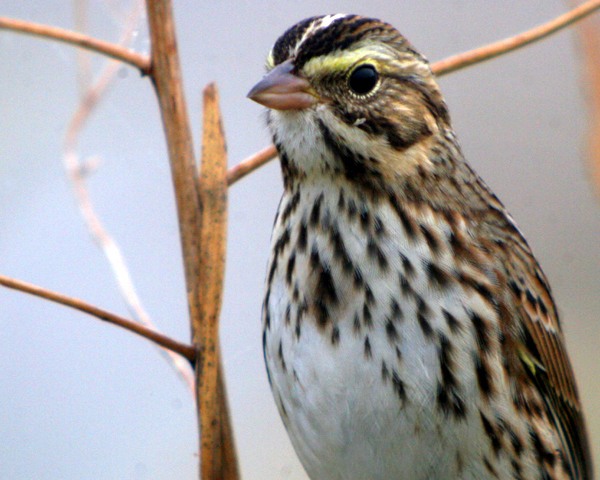
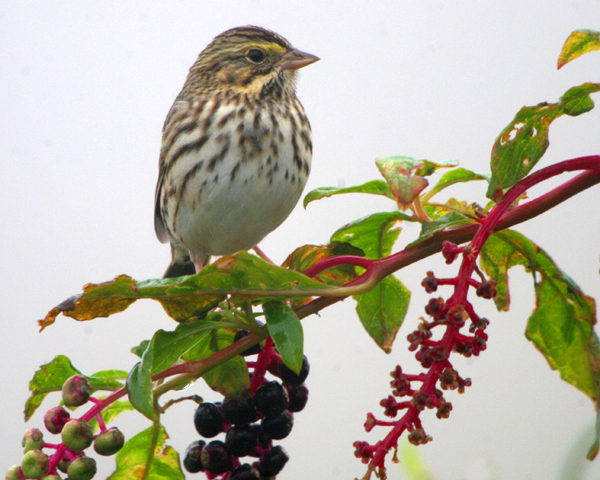
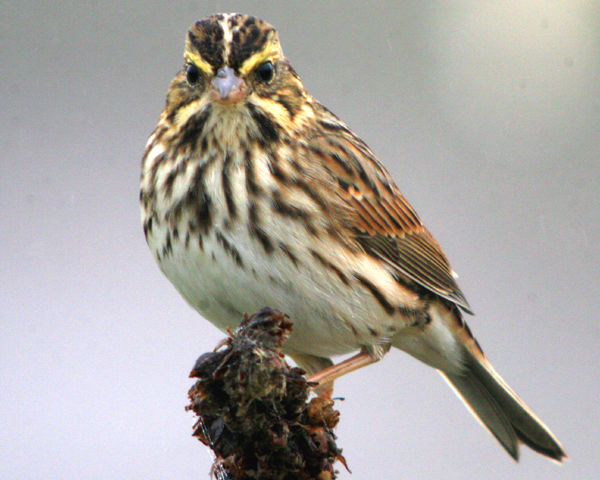
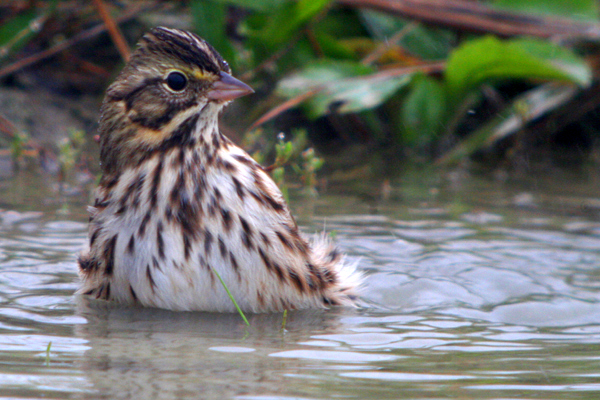
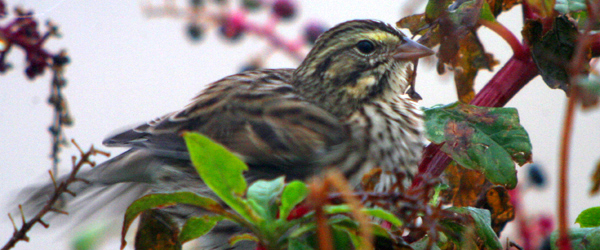
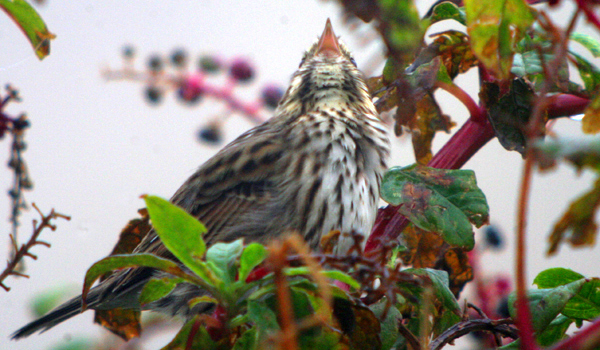
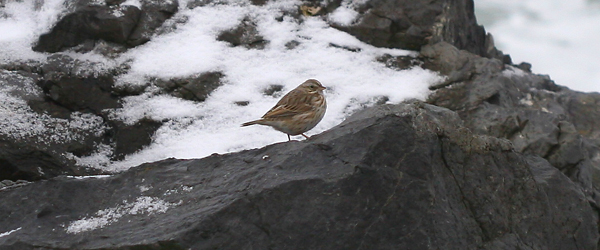
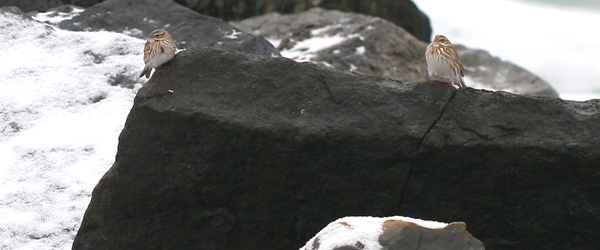
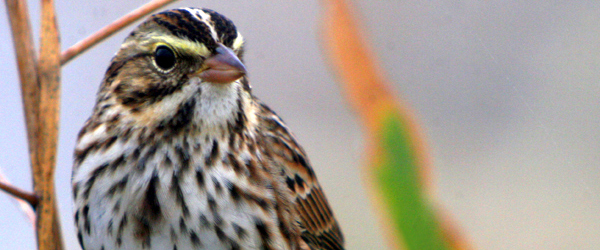



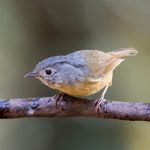






I’m proud to say that I logged them 40 times while I was working over in the Bay Area, so I’m right with you on this one, Corey. Got any idea why it’s sandwichensis, though?
Beautiful photos, Corey; thank you!
The taxonomic status of these “sparrowlets” (=Passerculus) is complex and still likely to change–with some surprising affiliations emerging. You can read about some of the debate on the page of the NACC at http://www.aou.org/committees/nacc/proposals/2008_A_votes_web.php#2008-A-8 . Note that beldingi and rostratus, both originally described as specifically distinct, were not “lumped” with other Savvies until 1945.
While “Savannah” refers to the city in Georgia, where Wilson first encountered the bird, “sandwichensis” is from Sandwich Bay, Unalaska, Alaska, the origin of the specimens described in 1789 by Gmelin.
I have to say I don’t know any discerning birders who don’t spend as much time as they can looking close at Savannah Sparrows. They’re great!
Corey, you continue to write great posts. Your writing is funny, it’s easy to read, and very human. In this post, you pick out an LBJ that gets no respect, and give it great respect. Kudos.
“…the Rodney Dangerfield of sparrows”. Excellent 🙂
@Andy: It looks like Rick beat me to it…
@Rick: Thanks for the info and correction! The post has been fixed. Everyone should visit Rick’s blog!
@Jory: Thanks! Hopefully I’ll gt up to Greene County one of these days to pay respect to that Swainson’s Hawk!
@Charlie: Check out this video…
Excellent pix. Thanks for posting.
I usually take a close look at them since I bird a lot of inland spots where they aren’t so common as to be taken for granted. A lot of the coastal spots in NJ have wintering Ipswich populations, especially around the Barnegat area.
@Rick: Wow! Fantastic response and so quick too. Thank you. Your next challenge is the other sandwichensis species – Hawaiian petrel, elepaio (also Hawaiian) and subspecies of emerald dove and short-eared owl. I was going to add sandwich tern but see that’s sandvicensis. I’m straying way off-topic here, so I’ll stop now.
@Opposable Chums: Thanks!
@John: I’m glad you give Savannah Sparrows the respect that they deserve.
@Andy Gibb: You’re making me hungry!
Excellent captures of one of my favorite sparrows Corey. I love them for a couple of reasons which you so aptly referred to: (1) the fact that they are easily pishable is a major plus and (2) their contrasting colors which include the yellow eyebrow with contrasting lateral crown stripe and reddish-brown greater coverts.
All in all, a very handsome bird! Thanks for pointing these features out to those less informed birders who might consider these simply LBJs. The third shot with the bird looking straight on is great as is the first and last photos that show off all of this species attributes. I must say that the Lincoln Sparrow that you mention is another of my favorites for similar reasons.
Great tribute to the Savannah Sparrow, Corey! I, for one, have often considered them as just another LBJ (see my most recent blog). Now I will be more appreciative of this species (including the various subspecies)
@Larry: You’ve summed up some of my thoughts about the species better than I did. Thanks!
@bob k: Glad I’ve changed your view a bit…good luck finding some of those rarer subspecies.
…I love Savannah Sparrows! They aren’t all that common around here, but I can usually spot them at VOA Park (Cincinnati) easily enough. Your photos are stunning. Love the bathing photo and the underside of his bill.
Just found your blog, sorry for the late comment. . .
As frustrating as they can be to ID from a distance, I find that many of the sparrows are quite dapper when you get a good view. I’m sure I’ve seen Savannah Sparrows down here in the mid-Atlantic, but I’ve been too ignorant to ID them. Thanks for the tips!
Hello from Richmond, British Columbia, Canada. I just stumbled across your blog, after checking out Google Images to see what kind of sparrow I had captured on my camera. You are right. Sparrows are overlooked. I have just recently taken up bird photography, and these small birds are hard to identify from a distance. I just shoot and identify later. I am surprised to see the beautiful detail on a lot of these birds.
Oh, any my bird is indeed a Savannah Sparrow.
I am currently engaged in putting a few of my photos on Google’s Picasa web.
Nice blog you have.
Sandy 🙂